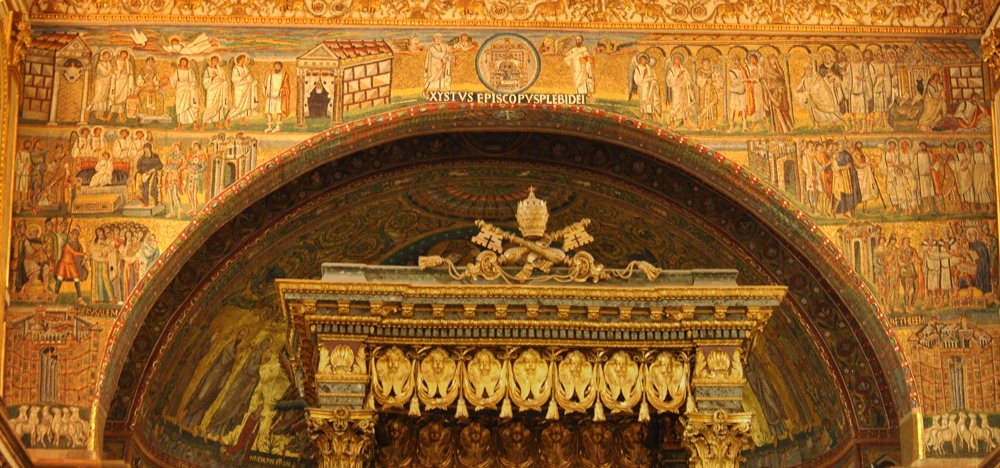The Triumphal Arch at Santa Maria Maggiore

432-440
Mosaic
Basilica of Santa Maria Maggiore, Rome
This was originally the apsidal arch, but in the 13th century the apse was moved back to make space for the transept and this became a "triumphal arch."
Santa Maria Maggiore was the first church in Rome dedicated to the Virgin Mary. Its construction in 432-440, and this mosaic in particular, were inspired by the formulations of the Council of Ephesus, which insist on the full divinity of Jesus Christ even from birth and therefore on the appropriateness of calling Mary the "Mother of God" (Schiller, I, 26-27).
As Schiller puts it, "the story of Christ's childhood is not told chronologically in the form of a narrative sequence, rather those scenes are chosen which demonstrate the divinity of the Child and the dawn of the era of salvation for the whole world." At the apex, Christ is presented symbolically as an enthroned cross flanked by Peter, Paul, and the beasts that represent the Evangelists. The narrative scenes in this uppermost register do follow a chronological sequence, with the annunciations to Mary and Joseph on the left (Luke 1:26-38, Matthew 1:20-23) and the presentation in the Temple and Joseph's second dream on the right (Luke 2:22-27, Matthew 2:19-20). In all the panels the angels and important male figures wear the garb of Roman Senators, a toga over a dalmatic with two vertical stripes. Joseph also wears a dalmatic, but instead of a toga his outer garment is a red/orange mantle. I am assuming that this expresses his inferior social status as a carpenter.
Grabar (47-48) sees the three registers as expressing Christ's power by following the pattern of Imperial mosaics: the upper register for the recognition of Christ's reign by his people (those attending the Annunciation on the left, the Presentation on the right), the middle register for recognition of his authority by foreigners (the Magi on the left, the Egyptians of Sotinen on the right), and the bottom register for the ruler's enemies (Herod meeting the Magi on the right and again on the left ordering the Slaughter of the Innocents).
In the second register on the left, the Child presides from a jeweled throne as the Magi arrive to give him homage (Matthew 2:9-11). In this panel Mary is as it were "refracted," pictured on Jesus' left as the earthly mother who gave him his fleshly body and also on his left as Maria Ecclesia, the eternal Mary, dressed in gold as she is in all the other panels. Joseph stands at the far left of the scene.
In the right panel of the second register the child is greeted by the people of Sotinen in Egypt as "the God of gods," a further testimony to his full divinity (Pseudo-Matthew, 22). The two men at the head of the welcomers are the governor Affrodisius and a man wearing an exomis, in classical iconography the attribute of a philosopher. Standing with the child are four angels, St. Joseph, and Mary in her golden garments.
The third register presents the two episodes from Matthew's nativity story that involve Herod, the earthly king in counterpoint to the King of Heaven in the panels above. On the right, advised about the ancient prophecy by the Jewish leaders (in white), he sends the Magi (in green) to Bethlehem (Matthew 2:7-8). On the left, when the Magi fail to report back, he orders the slaughter of Bethlehem's male babies (Matthew 2:16-18).
Finally, in the lowest register we see Bethlehem on the right and Jerusalem on the left, each looked to by six sheep representing the twelve tribes and the twelve apostles.
Detail photographs:
View this image in full resolution.
Read more about images of the Annunciation to Mary.
Read more about images of St. Joseph
Read more about images of the Presentation in the Temple
Read more about images of the Adoration of the Magi
Photographed at the basilica by Richard Stracke, shared under Attribution-NonCommercial-ShareAlike license.